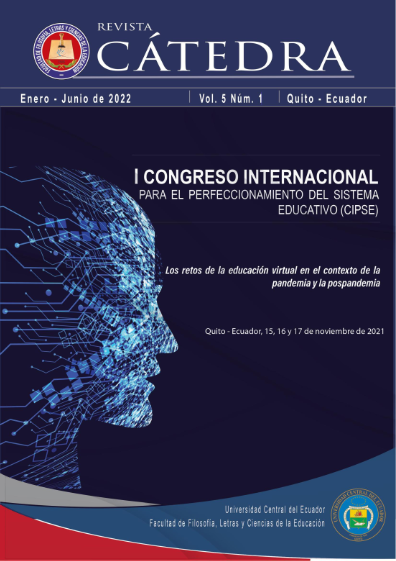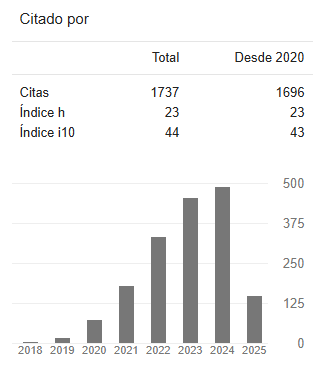Inclusion in times of pandemic: The advantages and difficulties of virtual education for students with functional diversity
DOI:
https://doi.org/10.29166/catedra.v5i1.3377Keywords:
universal design, functional diversity, virtual education, inclusion, pandemicAbstract
By the second half of March 2020, the leaders of many nations took drastic measures - isolation, closures and curfews - to stop the covid-19. One of the sectors most affected by these decisions was education: from preschool to university level. Faced with the cancellation of face-to-face classes, university institutions -prepared or not- opted for virtual education in order to save their finances and avoid student desertion. In spite of the difficulty of its implementation in the classroom, this modality has become very popular. This research arises from the need to examine the advantages and difficulties of virtual education for both typical students (those who do not have difficulties) and those who have some impediment during these last months. Likewise, the impact -favorable or adverse- of virtual education on the inclusion of students with functional diversity will be analyzed. Throughout this article, definitions such as virtual education, impairment, functional diversity, inclusion, reasonable accommodation/modification, and universal design will be provided. Finally, recommendations for incorporating universal design into online courses and what the future of education looks like in times of pandemic will be offered.
Downloads
References
Bérubé, M. (1996). Life as we know it: A father, a family, and an exceptional child. Random
House.
Corporación Ciudad Accesible (2012). ¿Qué es el diseño universal?
Recuperado de http://www.ciudadaccesible.cl/?p=1499
Educación Inclusiva. (2006). ¿Qué significa inclusión educativa?
Recuperado de http://www.inclusioneducativa.org/ise.php?id=1
Educación virtual, una alternativa para población en discapacidad. (8 de mayo de 2020).
El Tiempo. Recuperado de https://www.eltiempo.com/vida/educacion/educacion-
virtual-una-alternativa-para-poblacion-en-discapacidad-493404
Herrera Nieves, L. y Montes Soldado, R. (2018). Diseño universal de aprendizaje y
tecnologías de asistencia en ambientes educativos virtuales de nivel superior. Liderando investigación y prácticas inclusivas.
Recuperado de https://lsi2.ugr.es/rosana/investigacion/files/dua_TA_Herrera-Montes_2018.pdf
Ley de la Carta de Derechos de las Personas con Impedimentos, Ley Núm. 238 (Puerto
Rico, 2004). Recuperado de https://www.lexjuris.com/lexlex/Leyes2004/lexl2004238.htm
Ley de Servicios Educativos Integrales para Personas con Impedimentos, Ley Núm. 51
(Puerto Rico, 1996) Recuperado de https://www.lexjuris.com/LEXLEX/lexcodigoc/lexedimpedimentos.htm
Martínez Uribe, C.H. (2008). La educación a distancia: sus características y necesidad en la
Educación. 17(33), 7-27. Recuperado de file:///C:/Users/calau/Downloads/Dialnet-LaEducacionADistancia-5057022%20(5).pdf
Mas, A. (4 de abril de 2020). La educación online no llega a todos los alumnos. La
Vanguardia. Recuperado de https://www.lavanguardia.com/vida/formacion/20200414/48495012419/educacion-online-no-llega-todos-alumnos.html
Network Learning. (2021). Human rights and inclusion.
Recuperado de https://www.networklearning.org/index.php/ngo-fields/human-rights
Organization for Economic Cooperation and Development. (2020). Covid-19 en América
Latina y el Caribe: Panorama de las respuestas de los gobiernos a la crisis. Recuperado de https://www.oecd.org/coronavirus/policy-responses/covid-19-en-america-latina-y-el-caribe-panorama-de-las-respuestas-de-los-gobiernos-a-la-crisis-7d9f7a2b/
Organización Mundial de la Salud. (27 de abril de 2020). COVID-19: cronología de la
actuación de la OMS. Recuperado de https://www.who.int/es/news/item/27-04-2020-who-timeline---covid-19
Organización de las Naciones Unidas para la Educación, la Ciencia y la Cultura. (s.f.).
Inclusión en la educación. Recuperado de https://es.unesco.org/themes/inclusion-educacion
Pascuas Cortés, S.P. (14 de septiembre de 2020). COVID-19 en América: su impacto en
Puerto Rico. Asociación Latinoamericana de Historia.
Recuperado de https://www.asociacionlatinoamericanadehistoria.com/articulo/covid-19-en-america-su-impacto-en-puerto-rico/
Rama, C. (2016). La fase actual de expansión de la educación en línea o virtual en América
Latina. Universidades, 70, 27-39. Recuperado de https://www.redalyc.org/pdf/373/37348529004.pdf
Real Academia Española. (2021). Impedimento. En Diccionario de la lengua española.
Recuperado de https://dle.rae.es/impedimento
Redacción Educación. (8 de mayo de 2020). Educación virtual, una alternativa para
población en discapacidad. El Tiempo. https://www.eltiempo.com/vida/educacion/educacion-virtual-una-alternativa-para-poblacion-en-discapacidad-493404
Rose, D.H., y Meyer, A. (2002). Teaching every student in the digital age: Universal design for
learning. Association for Supervision and Curriculum Development. Alexandria, VA: ASCD.
Sánchez Fuentes, S., Díez Villoria, E. y Martín Almaraz, R.A. (2016). El diseño
universal como medio para atender la diversidad en la educación. Una revisión de casos de éxito en la universidad. Contextos Educativos, 19(2016), 121-131.
doi: 10.18172/con.275
Scott, R.A. (27 de agosto de 2021). Online Learning and Higher Ed’s Future. Higher Ed Jobs.
Serrano-Cumplido, A., Antón-Eguía Ortega, P.B., Ruiz García. A., Olmo Quintana, V., Segura
Fragoso, A., Barquilla García, A. y Morán Bayón, A. (2020) COVID-19. La historia se repite y seguimos tropezando con la misma piedra. Elsevier Public Health Emergency Collection. doi: http://10.1016/j.semerg.2020.06.008
Universidad de Alicante (2021a). Diversidad funcional. Unidad de Accesibilidad
Digital. Recuperado de https://web.ua.es/es/accesibilidad/diversidad-funcional.html
Universidad de Alicante (2021b). Diversidad funcional en las aulas. Unidad de Accesibilidad
Digital. Recuperado de https://web.ua.es/accesibilidad/educacion-inclusiva/diversidad-funcional-en-las-aulas.html
Downloads
Published
Versions
- 2022-09-22 (2)
- 2022-01-31 (1)









